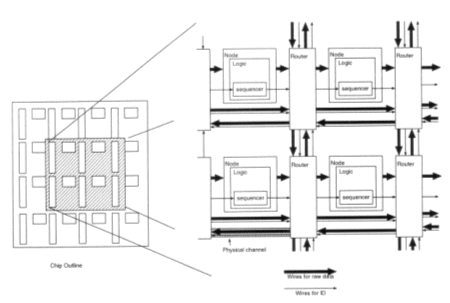Network on chip or network on a chip (NoC or NOC) is a communication subsystem on an integrated circuit (commonly called a "chip"), typically between intellectual property (IP) cores in a system on a chip (SoC). NoCs can span synchronous and asynchronous clock domains or use unclocked asynchronous logic. NoC technology applies networking theory and methods to on-chip communication and brings notable improvements over conventional bus and crossbar interconnections. NoC improves the scalability of SoCs, and the power efficiency of complex SoCs compared to other designs.
Contents
Parallelism and scalability
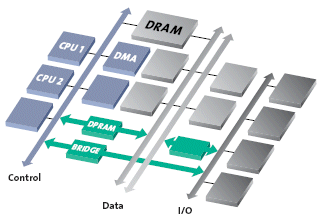
The wires in the links of the NoC are shared by many signals. A high level of parallelism is achieved, because all links in the NoC can operate simultaneously on different data packets. Therefore, as the complexity of integrated systems keeps growing, a NoC provides enhanced performance (such as throughput) and scalability in comparison with previous communication architectures (e.g., dedicated point-to-point signal wires, shared buses, or segmented buses with bridges). Of course, the algorithms must be designed in such a way that they offer large parallelism and can hence utilize the potential of NoC.
Benefits

Traditionally, ICs have been designed with dedicated point-to-point connections, with one wire dedicated to each signal. For large designs, in particular, this has several limitations from a physical design viewpoint. The wires occupy much of the area of the chip, and in nanometer CMOS technology, interconnects dominate both performance and dynamic power dissipation, as signal propagation in wires across the chip requires multiple clock cycles. (See Rent's rule for a discussion of wiring requirements for point-to-point connections).
Research on on-chip networks
Some researchers think that NoCs need to support quality of service (QoS), namely achieve the various requirements in terms of throughput, end-to-end delays, fairness, and deadlines. Real-time computation, including audio and video playback, is one reason for providing QoS support. However, current system implementations like VxWorks, RTLinux or QNX are able to achieve sub-millisecond real-time computing without special hardware. This may indicate that for many real-time applications the service quality of existing on-chip interconnect infrastructure is sufficient, and dedicated hardware logic would be necessary to achieve microsecond precision, a degree that is rarely needed in practice for end users (sound or video jitter need only tenth of milliseconds latency guarantee). Another motivation for NoC-level quality-of-service is to support multiple concurrent users sharing resources of a single chip multiprocessor in a public cloud computing infrastructure. In such instances, hardware QOS logic enables the service provider to make contractual guarantees on the level of service that a user receives, a feature that may be deemed desirable by some corporate or government clients.
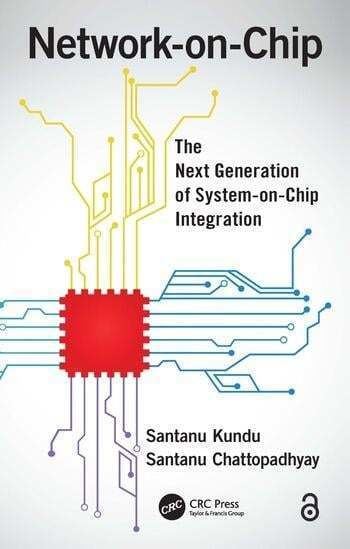
Many challenging research problems remain to be solved at all levels, from the physical link level through the network level, and all the way up to the system architecture and application software. The first dedicated research symposium on networks on chip was held at Princeton University, in May 2007. The second IEEE International Symposium on Networks-on-Chip was held in April 2008 at Newcastle University.
Research has been done on integrated optical waveguides and devices comprising an optical network on a chip (ONoC).
Benchmarks
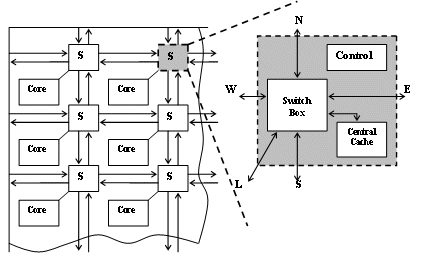
NoC development and studies require comparing different proposals and options. And NoC traffic patterns are developed to help such evaluations. Existing NoC benchmarks include NoCBench and MCSL NoC Traffic Patterns.
Interconnect processing nit
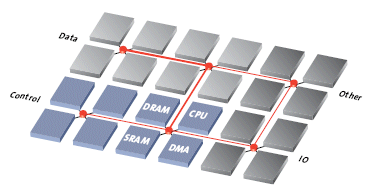
An interconnect processing unit (IPU) is essentially an on-chip communication network (NoC) with hardware and software components which jointly implement key functions of different SoC programming models through a set of communication and synchronization primitives and provide low-level platform services to enable advanced features in modern heterogeneous applications on a single die.
Commercial providers
